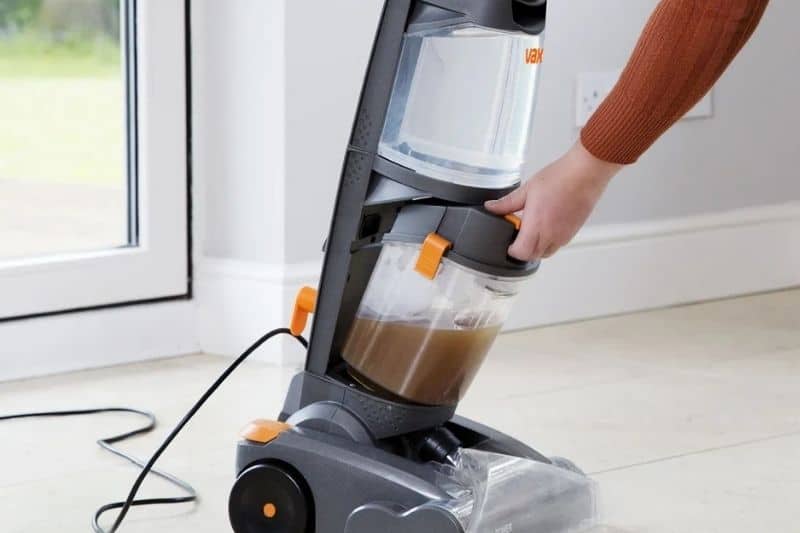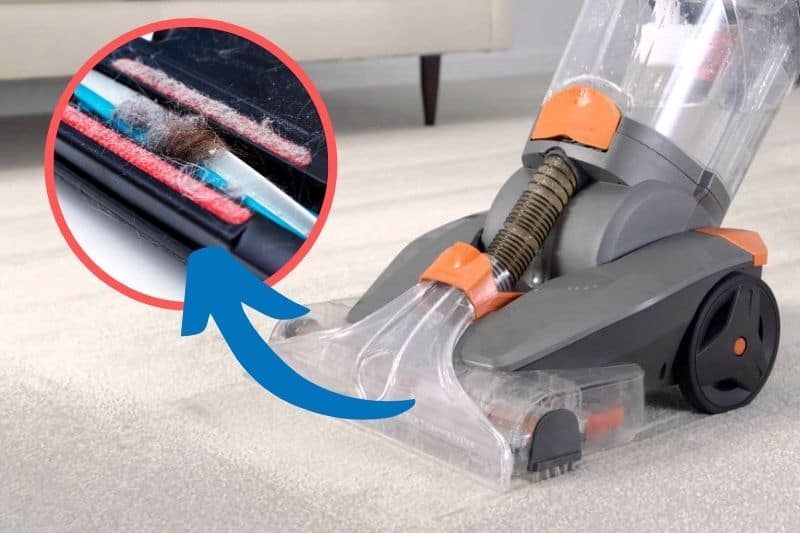Why is My Carpet Cleaner Not Picking Up the Dirty Water due to clogged filters or a full recovery tank? Blockages in the nozzle or hoses could also cause this issue.
Carpet cleaners operate by injecting water and cleaning solution into the carpet and then sucking up the dirty water. Encountering a problem where the machine fails to perform this essential function can be frustrating. Regular maintenance, such as cleaning filters, emptying and rinsing out tanks, and checking for blockages in the pathways, is crucial for optimal performance.
Users often overlook these simple upkeep steps, leading to common operational issues like poor suction. Ensuring that your carpet cleaner is well-maintained will help it work efficiently and extend its lifespan. Always consult your cleaner’s user manual for specific troubleshooting and care instructions to keep your machine running smoothly.

Understanding Carpet Cleaner Mechanics
Understanding Carpet Cleaner Mechanics is essential for troubleshooting common issues like machines failing to pick up dirty water. A carpet cleaner is a sophisticated tool that performs its job efficiently when all parts work together harmoniously. Let’s dig into the mechanics of how these machines function and resolve the mystery surrounding water extraction problems.
Basic Principles Of A Carpet Cleaner’s Function
On a fundamental level, a carpet cleaner sprays water and cleaning solution onto the carpet. It then scrubs out the dirt and sucks up the grimy water. This process involves several components working in unison:
- Water Pump: It pressurizes and pushes the cleaning solution into the carpet.
- Scrub Brushes: They dislodge dirt from the carpet fibers.
- Vacuum Motor: This creates suction to remove dirty water.
- Recovery Tank: It holds the extracted dirty water.
The Role Of Suction In Water Extraction
The vacuum motor is the heart of the water extraction process. Without adequate suction, dirty water remains in the carpet. Here’s how suction is supposed to happen:
- The vacuum motor generates a negative air pressure.
- This negative pressure creates a vacuum effect.
- Dirty water lifts from the carpet and moves into the recovery tank.
If a carpet cleaner stops picking up dirty water, inspect these components for issues:
| Component | Common Issue | Action Required |
|---|---|---|
| Vacuum Motor | Loss of suction power. | Check for blockages or malfunctions. |
| Hoses or Nozzles | Clogs or leaks. | Unclog and ensure a tight seal. |
| Recovery Tank | Not seated properly or full. | Empty the tank and secure it in place. |
Common Reasons For Loss Of Suction
Troubles with your carpet cleaner can be a real headache. When your device fails to pick up dirty water, it compromises cleanliness. Various issues might lead to loss of suction power. Identifying common causes helps resolve them quickly.
Clogged Filters And Their Impact
Filters play a key role in vacuum health. A clean filter ensures good airflow and suction. Over time, debris and dust can clog it. This may lead to reduced suction. Regular maintenance is crucial.
- Check filters regularly
- Clean or replace when needed
When filters get clogged, the efficiency of your carpet cleaner takes a dip. This means the equipment can’t pull water properly. Keep an eye on these components to maintain optimal performance.
Blockages In The Nozzle Or Hose
A clear path is vital for effective water extraction. The nozzle and hose can gather debris. This restricts water flow and suction.
- Inspect the nozzle and hose for obstructions
- Carefully remove any blockages you find
Ensuring these parts are clean and clear can dramatically improve suction power. A thorough check can reveal hidden issues affecting functionality.
Troubleshooting Dirty Water Recovery Issues
When your carpet cleaner fails to pick up dirty water, it can be frustrating. Understanding the root of the problem is key. In this section, let’s tackle common issues and maintenance tips. This approach ensures your carpet cleaner operates flawlessly, safeguarding its longevity and cleaning efficiency.
Steps To Diagnose Your Carpet Cleaner
Identify the problem with the following steps:
- Check the tank. It must not be full.
- Inspect the tank’s position. It needs to sit properly in the machine.
- Examine the nozzle. It must be free from clogs.
- Look at the filters. Clean them if they are dirty.
- Consult the user manual. It can have model-specific advice.
How To Perform Basic Cleaner Maintenance
Regular upkeep boosts your machine’s performance:
- Clean the tank after each use. Make sure it’s dry before you put it back.
- Remove debris from the nozzle. Use a soft brush for stubborn dirt.
- Wash or replace filters as suggested in the manual.
- Check and maintain the brushes. Ensure they spin freely.
- Look for hose blockages. Remove obstructions if present.
Preventive care keeps your cleaner ready for the next use.

Diy Fixes For The Home User
Is your carpet cleaner not doing its job? Frustration kicks in when your carpet cleaner leaves behind a mess instead of making your carpets spotless. Let’s try some easy DIY fixes that can bring your carpet cleaner back to life without a trip to the repair shop!
Clearing Obstructions From Key Components
Sometimes, the simplest solutions are right at our fingertips. A common issue with carpet cleaners not sucking up water is clogs. These are the steps to get your machine running smoothly:
- Turn off and unplug your carpet cleaner.
- Remove the water tank and check for clogs in its base.
- Inspect the suction gate for any lodged debris.
- Check the hose for twists, kinks, or blocks.
- Clean the brush rolls to ensure they spin freely.
- Then, reassemble and test your machine.
Replacing Worn Or Damaged Parts
Over time, parts of your carpet cleaner can wear out or break. Here’s how to identify and replace them:
- Check all seals and gaskets; they must be intact.
- Ensure the water tank is not cracked and is fitting properly.
- Examine belts for breakage or excessive wear.
- Replace any damaged or worn parts.
- Refer to your cleaner’s manual for specific part numbers and installation guides.
Remember, always consult your manual for exact replacement procedures and parts suitable for your model. This will save your time and keep your carpet cleaner running effectively!
When To Seek Professional Help
Understanding when to call a professional can save both your carpet cleaner and your peace of mind. Sometimes the fix is not a simple DIY task. Knowing the signs that professional help is needed can prevent further damage to your machine. Let’s explore common signs signaling it’s time to seek professional assistance.
Identifying Problems Beyond Diy Capabilities
Detecting issues outside your fix-it skills is crucial. Look for these cues:
- Motor sounds odd: A humming or buzzing that’s not typical.
- Water doesn’t eject: It may be a pump issue, not just a clog.
- Suction fails: When basic troubleshooting doesn’t restore it.
- Leakage occurs: This can point to internal seal problems.
- Burning smell: Indicates potential motor or belt damage.
If these issues persist after following the manufacturer’s tips, it’s time for expert help.
Finding A Trusted Repair Service
Choosing a reliable service is vital. Here’s a guide to find the best one:
| Step | Action |
|---|---|
| 1 | Search for certified repair shops with high ratings. |
| 2 | Check reviews for positive customer service experiences. |
| 3 | Confirm that the service uses quality parts and offers a guarantee. |
| 4 | Ask about their experience with your carpet cleaner brand. |
| 5 | Compare prices but don’t choose based on cost alone. |
Remember: Trustworthy services have transparent policies and clear communication.
Preventative Measures And Best Practices
Preventative Measures and Best Practices are crucial for keeping your carpet cleaner functioning efficiently. By avoiding common pitfalls and following expert advice, you can ensure your appliance remains in top condition. Let’s explore some key steps every homeowner can take.
Routine Maintenance To Prevent Issues
Keeping your carpet cleaner in pristine condition requires regular check-ups. This not only prolongs its lifespan but also assures superior cleaning results. Take note of the following routine maintenance tips:
- Clean filters after each use to prevent clogging.
- Inspect belts for wear and tear; replace as necessary.
- Empty and rinse the dirty water tank to eliminate residues.
- Check brushes for entangled fibers and debris.
- Ensure the water lines are clear of any blockages.
Usage Tips For Optimal Carpet Cleaner Performance
To get the most out of your carpet cleaner, adhere to these usage tips. Proper operation guarantees effective cleaning and prevents water pickup issues.
- Only use recommended cleaning solutions.
- Adjust settings based on your carpet type.
- Do not over-saturate; use the appropriate amount of water.
- Pre-treat stains to alleviate the cleaner’s workload.
- Move at a steady pace to allow water extraction.
By following these preventative tips and best practices, you can avoid the frustration of a cleaner that fails to pick up dirty water and enjoy carpets that are both clean and dry.

Frequently Asked Questions On Why Is My Carpet Cleaner Not Picking Up The Dirty Water
Why Is My Bissell Not Collecting Dirty Water?
Your Bissell may not collect dirty water due to a full tank, clogged nozzle, incorrect tank insertion, or a suction issue. Empty the tank, check for blockages, ensure proper tank placement, and verify the suction function for a solution.
Why Is My Rug Doctor Not Collecting Dirty Water?
Your Rug Doctor may not be collecting dirty water due to a full recovery tank, clogged filter, improperly seated tank, or suction issues. Check and resolve these components for proper functionality.
Why Is My Carpet Shampooer Not Picking Up Water?
Your carpet shampooer might not be picking up water due to a clogged nozzle, full recovery tank, or malfunctioning suction motor. Check for blockages, empty the tank, and inspect the motor to ensure proper functionality.
Why Is My Bissell Not Suctioning?
Your Bissell may lack suction due to a full dirt container, clogged filters, hose blockages, or a damaged belt. Regular maintenance and checking these areas can often resolve the issue.
Conclusion
Confronting issues with your carpet cleaner can be frustrating. Simple troubleshooting can often resolve the problem. Regular maintenance and proper use are key. For persistent issues, professional advice might be necessary. Keep your cleaning routine effective and your carpets impeccable with these insights.

